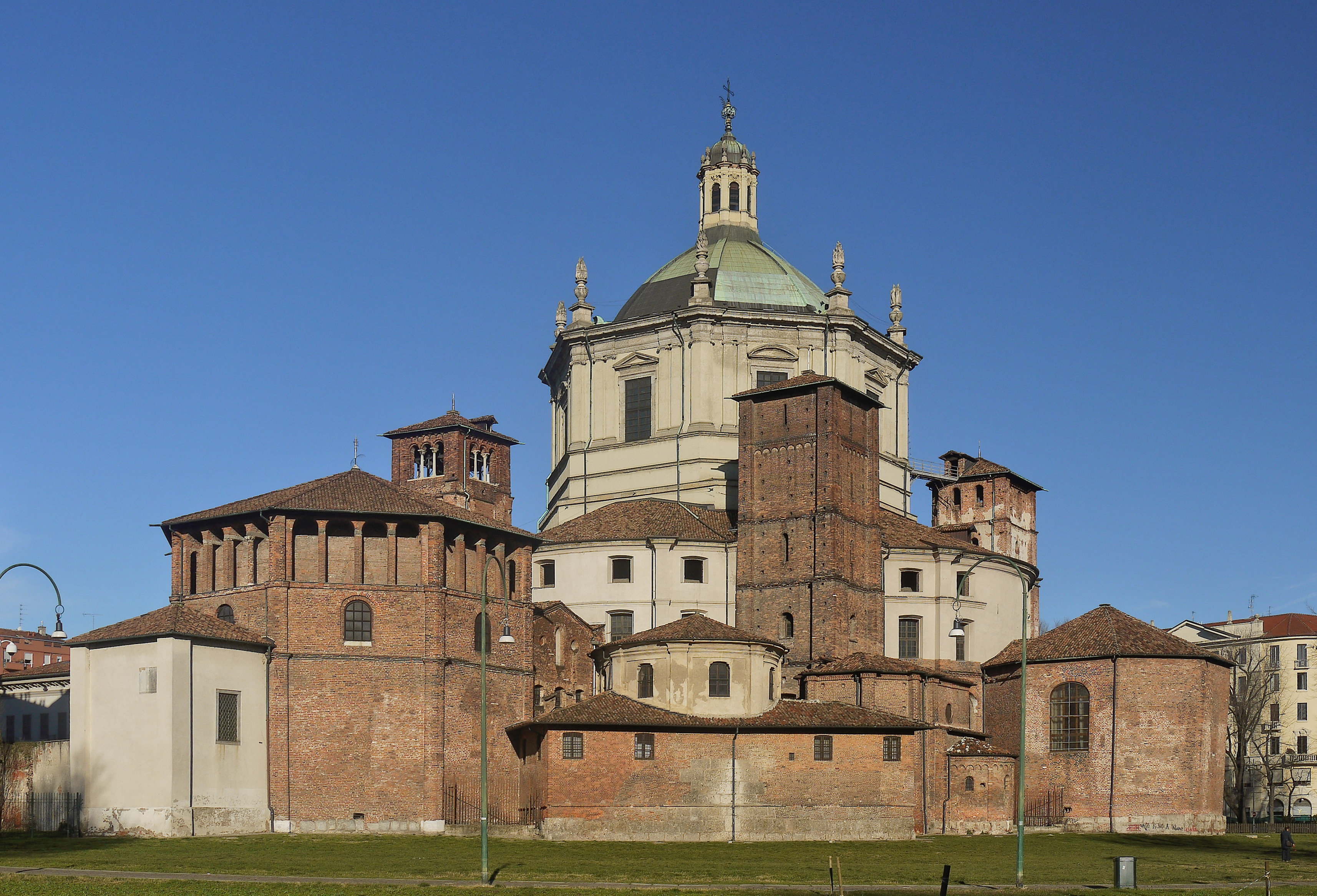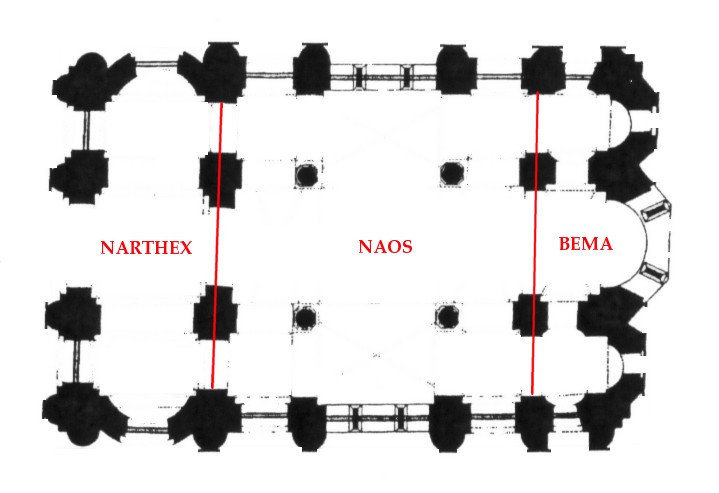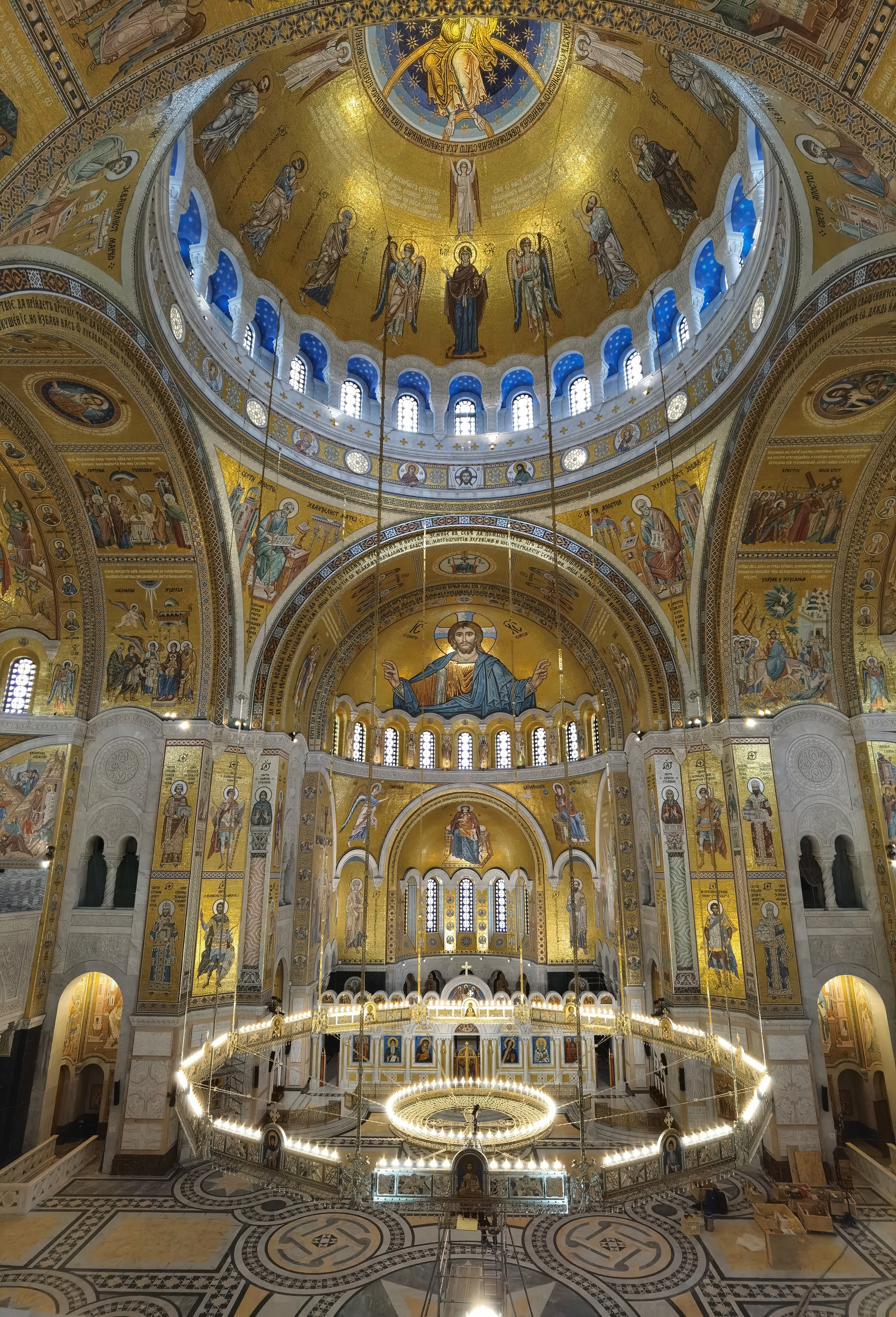|
Tetraconch
A tetraconch, from the Greek for "four shells", is a building, usually a church or other religious building, with four apses, one in each direction, usually of equal size. The basic ground plan of the building is therefore a Greek cross. They are most common in Byzantine, and related schools such as Armenian and Georgian architecture. It has been argued that they were developed in these areas or Syria, and the issue is a matter of contention between the two nations in the Caucasus. Apart from churches, the form is suitable for a mausoleum or baptistery. Normally, there will be a higher central dome over the central space. Overview The Basilica of San Lorenzo, Milan (370) is possibly the first example of a grander type, the "aisled tetraconch", with an outer ambulatory. In middle Byzantine architecture, the cross-in-square plan was developed, essentially filling out the tetraconch to form a square-ish exterior. Either of these types may also be described less precisely as ... [...More Info...] [...Related Items...] OR: [Wikipedia] [Google] [Baidu] |
Zvartnots Cathedral
Zvartnots Cathedral ( hy, Զուարթնոց ( classical); (reformed), sometimes rendered in scholarly works as Zuart'nots' or Zuart'noc' ; literally 'celestial angels cathedral') is a medieval Armenian cathedral near Vagharshapat (Ejmiatsin), Armenia. Built in the seventh century and now lying in ruins, Zvartnots was noted for its circular exterior structure, unique in medieval Armenian architecture, and a set of interior piers that upheld a multifloor structure crowned with a dome. History Zvartnots was built during the first Muslim Arab raids to capture and conquer the territories of Byzantine and Sasanian Armenia. Construction of the cathedral began in 643, under the guidance of Catholicos Nerses III the Builder (''Shinogh''). Dedicated to St. Gregory, the cathedral was built on a location where a meeting between King Trdat III and Gregory the Illuminator was said to have taken place. According to the medieval Armenian historian Movses Kaghankatvatsi, the cathedral w ... [...More Info...] [...Related Items...] OR: [Wikipedia] [Google] [Baidu] |
Cross-in-square
A cross-in-square or crossed-dome plan was the dominant architectural form of middle- and late-period Byzantine churches. It featured a square centre with an internal structure shaped like a cross, topped by a dome. The first cross-in-square churches were probably built in the late 8th century, and the form has remained in use throughout the Orthodox world unto the present day. In the West, Donato Bramante's first design (1506) for St. Peter's Basilica was a centrally planned cross-in-square under a dome and four subsidiary domes. In German, such a church is a , or ‘cross-dome church’. In French, it is an , ‘church with an inscribed cross’. Architecture Architectural form A cross-in-square church is centered around a quadratic naos (the ‘square’) which is divided by four columns or piers into nine bays (divisions of space). The inner five divisions form the shape of a quincunx (the ‘cross’). The central bay is usually larger than the other eight, and ... [...More Info...] [...Related Items...] OR: [Wikipedia] [Google] [Baidu] |
Ninotsminda Cathedral
Ninotsminda Cathedral ( ka, ნინოწმინდის მონასტერი) (c. 575) is located in the village of Sagarejo, in the Kakheti region, Georgia. Ninotsminda Cathedral is highly significant to the development of Georgian architecture, as it predates Jvari Monastery in Mtskheta, and served as a model for the development of the later tetraconch (four-apse) form. The site is ruins today, with only the eastern apse and a portion of the western wall remaining. The ruined apse is decorated with 16th century frescos of the Hodegetria, severely vandalised with bullet holes from Dagestani bandits in the 18th and 19th centuries. Outlines of the foundations indicate that the church originally had an octagonal center, surrounded by corner niches. Historical records indicate that restoration work was undertaken in the 10th and 11th centuries, and also during 1671 and 1774. However, the cathedral collapsed during earthquakes in 1824 and 1848 and was not reconstructed. ... [...More Info...] [...Related Items...] OR: [Wikipedia] [Google] [Baidu] |
Semi-dome
In architecture, a semi-dome (or half-dome) is a half dome that covers a semi-circular area in a building. Architecture Semi-domes are a common feature of apses in Ancient Roman In modern historiography, ancient Rome refers to Roman civilisation from the founding of the city of Rome in the 8th century BC to the collapse of the Western Roman Empire in the 5th century AD. It encompasses the Roman Kingdom (753–509 B ... and traditional church architecture, and in mosques and iwans in Islamic architecture. A semi-dome, or the whole apse, may also be called a conch after the scallop shell often carved as decoration of the semi-dome (all shells were conches in Ancient Greek), though this is usually used for subsidiary semi-domes, rather than the one over the main apse. Small semi-domes have been often decorated in a shell shape from ancient times, as in Piero della Francesca's ''Throned Madonna with saints and Federigo da Montefeltro'', and the example in the gallery below. ... [...More Info...] [...Related Items...] OR: [Wikipedia] [Google] [Baidu] |
Jvari (monastery)
:''The name of this monastery translated as the "Monastery of the Cross". For the Georgian monastery in Jerusalem with the same name, see Monastery of the Cross.'' Jvari Monastery () is a sixth-century Georgian Orthodox monastery near Mtskheta, eastern Georgia. Jvari is a rare case of an Early Medieval Georgian church that has survived to the present day almost unchanged. The church became the founder of its type, the Jvari type of church architecture, prevalent in Georgia and Armenia. Built atop of Jvari Mount (656 m a.s.l.), the monastery is an example of harmonious connection with the natural environment, characteristic to medieval Georgian architecture. Along with other historic structures of Mtskheta, the monastery was listed as a World Heritage Site by UNESCO in 1994. History Jvari Monastery stands on the rocky mountaintop at the confluence of the Mtkvari and Aragvi rivers, overlooking the town of Mtskheta, which was formerly the capital of the Kingdom of Iberia. Acc ... [...More Info...] [...Related Items...] OR: [Wikipedia] [Google] [Baidu] |
Cross-in-square
A cross-in-square or crossed-dome plan was the dominant architectural form of middle- and late-period Byzantine churches. It featured a square centre with an internal structure shaped like a cross, topped by a dome. The first cross-in-square churches were probably built in the late 8th century, and the form has remained in use throughout the Orthodox world unto the present day. In the West, Donato Bramante's first design (1506) for St. Peter's Basilica was a centrally planned cross-in-square under a dome and four subsidiary domes. In German, such a church is a , or ‘cross-dome church’. In French, it is an , ‘church with an inscribed cross’. Architecture Architectural form A cross-in-square church is centered around a quadratic naos (the ‘square’) which is divided by four columns or piers into nine bays (divisions of space). The inner five divisions form the shape of a quincunx (the ‘cross’). The central bay is usually larger than the other eight, and ... [...More Info...] [...Related Items...] OR: [Wikipedia] [Google] [Baidu] |
Church Of Saint Sava
The Temple of Saint Sava ( sr-Cyrl, Храм Светог Саве, Hram Svetog Save, lit='The Temple of Saint Sava') is a Serbian Orthodox church which sits on the Vračar plateau in Belgrade, Serbia. It was planned as the bishopric seat and main cathedral of the Serbian Orthodox Church. The church is dedicated to Saint Sava, the founder of the Serbian Orthodox Church and an important figure in medieval Serbia. It is built on the presumed location of St. Sava's grave. His coffin had been moved from Mileševa Monastery to Belgrade. The coffin was placed on a pyre and burnt in 1595 by Ottoman Grand Vizier Sinan Pasha. Bogdan Nestorović and Aleksandar Deroko were finally chosen to be the architects in 1932 after a second revised competition in 1926–27 (for which no first award was granted, Nestorović being runner up). This sudden decision instigated an important debate in interwar Yugoslavia which centered around the temple's size, design and symbolic national functio ... [...More Info...] [...Related Items...] OR: [Wikipedia] [Google] [Baidu] |
Armenia
Armenia (), , group=pron officially the Republic of Armenia,, is a landlocked country in the Armenian Highlands of Western Asia.The UNbr>classification of world regions places Armenia in Western Asia; the CIA World Factbook , , and ''Oxford Reference Online'' also place Armenia in Asia. It is a part of the Caucasus region; and is bordered by Turkey to the west, Georgia to the north, the Lachin corridor (under a Russian peacekeeping force) and Azerbaijan to the east, and Iran and the Azerbaijani exclave of Nakhchivan to the south. Yerevan is the capital, largest city and the financial center. Armenia is a unitary, multi-party, democratic nation-state with an ancient cultural heritage. The first Armenian state of Urartu was established in 860 BC, and by the 6th century BC it was replaced by the Satrapy of Armenia. The Kingdom of Armenia reached its height under Tigranes the Great in the 1st century BC and in the year 301 became the first state in the worl ... [...More Info...] [...Related Items...] OR: [Wikipedia] [Google] [Baidu] |
Basilica Of St
In Ancient Roman architecture, a basilica is a large public building with multiple functions, typically built alongside the town's forum. The basilica was in the Latin West equivalent to a stoa in the Greek East. The building gave its name to the architectural form of the basilica. Originally, a basilica was an ancient Roman public building, where courts were held, as well as serving other official and public functions. Basilicas are typically rectangular buildings with a central nave flanked by two or more longitudinal aisles, with the roof at two levels, being higher in the centre over the nave to admit a clerestory and lower over the side-aisles. An apse at one end, or less frequently at both ends or on the side, usually contained the raised tribunal occupied by the Roman magistrates. The basilica was centrally located in every Roman town, usually adjacent to the forum and often opposite a temple in imperial-era forums. Basilicas were also built in private residences ... [...More Info...] [...Related Items...] OR: [Wikipedia] [Google] [Baidu] |
Western Christianity
Western Christianity is one of two sub-divisions of Christianity Christianity is an Abrahamic monotheistic religion based on the life and teachings of Jesus of Nazareth Jesus, likely from he, יֵשׁוּעַ, translit=Yēšūaʿ, label=Hebrew/Aramaic ( AD 30 or 33), also referred to as Jesu ... (Eastern Christianity being the other). Western Christianity is composed of the Latin Church and Protestantism, Western Protestantism, together with their offshoots such as the Old Catholic Church, Independent Catholicism and Restorationism. The large majority of the world's 2.3 billion Christians are Western Christians (about 2 billion – 1.2 billion Latin Catholic and 800 million Protestant). The original and still major component, the Latin Church, developed under the bishop of Rome. Out of the Latin Church emerged a wide variety of independent Protestant denominations, including Lutheranism and Anglicanism, starting from the Protestant Ref ... [...More Info...] [...Related Items...] OR: [Wikipedia] [Google] [Baidu] |
Mosaic
A mosaic is a pattern or image made of small regular or irregular pieces of colored stone, glass or ceramic, held in place by plaster/mortar, and covering a surface. Mosaics are often used as floor and wall decoration, and were particularly popular in the Ancient Roman world. Mosaic today includes not just murals and pavements, but also artwork, hobby crafts, and industrial and construction forms. Mosaics have a long history, starting in Mesopotamia in the 3rd millennium BC. Pebble mosaics were made in Tiryns in Mycenean Greece; mosaics with patterns and pictures became widespread in classical times, both in Ancient Greece and Ancient Rome. Early Christian basilicas from the 4th century onwards were decorated with wall and ceiling mosaics. Mosaic art flourished in the Byzantine Empire from the 6th to the 15th centuries; that tradition was adopted by the Norman Kingdom of Sicily in the 12th century, by the eastern-influenced Republic of Venice, and among the Rus. Mosaic fell ... [...More Info...] [...Related Items...] OR: [Wikipedia] [Google] [Baidu] |
Ravenna
Ravenna ( , , also ; rgn, Ravèna) is the capital city of the Province of Ravenna, in the Emilia-Romagna region of Northern Italy. It was the capital city of the Western Roman Empire from 408 until its collapse in 476. It then served as the capital of the Ostrogothic Kingdom until it was re-conquered in 540 by the Byzantine Empire. Afterwards, the city formed the centre of the Byzantine Exarchate of Ravenna until the last exarch was executed by the Lombards in 751. Although it is an inland city, Ravenna is connected to the Adriatic Sea by the Candiano Canal. It is known for its well-preserved late Roman and Byzantine architecture, with eight buildings comprising the UNESCO World Heritage Site "Early Christian Monuments of Ravenna". History The origin of the name ''Ravenna'' is unclear. Some have speculated that "Ravenna" is related to "Rasenna" (or "Rasna"), the term that the Etruscans used for themselves, but there is no agreement on this point. Ancient era The origins o ... [...More Info...] [...Related Items...] OR: [Wikipedia] [Google] [Baidu] |










.png)